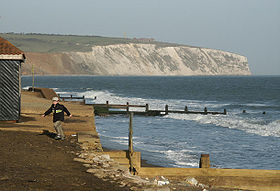Culver Down
| Culver Down | |
|---|---|

Culver Down seen from Sandown Bay, 2003
|
|
| Highest point | |
| Elevation | 104 m (341 ft) |
| Geography | |
| Location | Isle of Wight, England |
| OS grid | SZ631856 |
| Topo map | OS Landranger 196 |
Culver Down is a chalk down to the north of Sandown, Isle of Wight. It is believed that its name derives from "Culfre", which is Old English for dove.
The down has a typical chalk downland wildlife on the uncultivated areas (generally the southern and eastern slopes). This includes plants such as Small Scabious, Harebell, Cowslip and Lady's Bedstraw. The chalk cliffs to the north and east are important nesting places for seabirds. Historically, Culver has been the source of commercial bird's egg collecting from ropes over the cliff. It was also known for breeding peregrine falcons, as well as breeding Common Woodpigeons (Culvers), the source of the cliff's name.
The northern side is intensively grazed by cattle, so fertilization and poaching of the soil, not to mention a spell as an artillery training ground, have all but eliminated the natural chalk ecosystem.
On Culver Down a number of unusual ant species live, including the semi-myrmecophilous Solenopsis fugax (Latr.), a thief ant which was recorded there several times by Horace Donisthorpe. The ant Ponera coarctata has also been taken from this location.
The public parts of this prominent headland are owned and managed by the National Trust. Spectacular views of the English Channel can be had.
For many years the whole site was a military zone and not open to the public. There are several historic military features on the down, a number of private dwellings, the Culver Haven pub, and the very visible Monument. The military barracks which once adjoined the monument has been almost completely erased, but there is a substantial fort, now under the ownership of the National Trust and occasionally opened to the public. Part of the fort is leased to Micronair, manufacturing crop-spraying and military equipment. It is a Palmerston Fort, constructed in the 1860s. At the end of the cliff is a coastal and anti-aircraft battery from the Second World War.
...
Wikipedia
